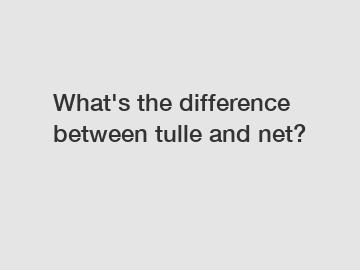What's the difference between tulle and net?
Disclaimer: This article has been written by an AI language model, and while it has been trained on a wide range of information, it is important to fact-check and use your own judgement when using the information provided.
When it comes to fabrics for creating or embellishing beautiful garments, two types that often confuse people are tulle and net. They appear similar at first glance, but upon closer inspection, they have distinct characteristics that set them apart. In this article, we'll explore the difference between tulle and net, shedding light on their unique features and their individual uses in the world of fashion and beyond.
Tulle, a lightweight and fine fabric, is commonly used in bridal veils, tutus, and ballerina skirts. Its origin can be traced back to the city of Tulle in France, from which it gets its name. Tulle is usually made from various fibers, including silk, nylon, rayon, and even cotton. Its delicate appearance can be attributed to its fine net-like structure, which consists of closely woven hexagonal meshes.

One of the key characteristics of tulle is its softness. When you touch tulle fabric, it feels light and airy, almost like a whisper against your skin. The delicate nature of tulle makes it perfect for creating ethereal and romantic pieces of clothing. Its sheer quality often requires layering or a lining fabric to maintain modesty. The translucency of tulle allows designers to play with colors by layering different shades, resulting in a subtle and enchanting effect.
On the other hand, net, also known as mesh, is a versatile fabric with a more sturdy and robust structure compared to tulle. Net is made by knotting, twisting, or knitting yarns together, resulting in a loosely woven or knitted fabric with evenly spaced holes. These holes are usually square or diamond-shaped, giving net a distinct appearance.
The primary characteristic of net is its strength. This makes it ideal for creating garments that require stability and structure, such as dresses, skirts, and dress overlays. Unlike tulle, net can be used as a standalone fabric without the need for additional layers or linings. Its opaque nature offers more coverage, while also allowing designers to experiment with embellishments like sequins or embroidery.
Both tulle and net have a wide range of applications in the fashion industry. Tulle's lightness and delicate texture make it popular for bridal wear, evening gowns, and dance costumes. Its use in veils adds a touch of romance, while in skirts and dresses, it creates volume and movement. Tulle is also used in home decor, gift wrapping, and DIY projects due to its versatility and whimsical charm.
Net, on the other hand, finds popularity in sportswear, lingerie, and accessories. Its durability and breathability make it suitable for creating athletic wear and undergarments. Net is often used in hats, fascinators, and veiling for its ability to hold its shape and add a touch of elegance.
In terms of care and maintenance, both tulle and net are relatively easy to handle. These fabrics are generally machine-washable, although it is recommended to use a gentle cycle and avoid high temperatures to preserve their delicate structure. It's always best to follow the care instructions provided by the manufacturer to ensure longevity.
In conclusion, while tulle and net may appear similar at first glance, they possess unique characteristics that set them apart. Tulle's softness, sheer appearance, and romantic aura make it perfect for creating ethereal designs. Net, with its sturdiness and versatility, finds its place in creating structured garments and accessories. Understanding the difference between these two fabrics opens up a world of creativity and possibilities for designers, enabling them to bring their visions to life. So next time you stroll through a boutique or plan a DIY project, pay attention to the fabric used, and unravel the delicate mysteries of tulle and net.
For more information, please visit polyester big hole mesh fabric, polyester brushed fabric supplier, athletic mesh fabric.

Comments
0